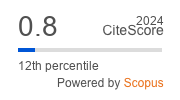Fault-tolerant self-timed counters
https://doi.org/10.17073/1609-3577j.met202310.588
Abstract
The article studies the fault-tolerant self-timed (ST) counter design problem. Combinational ST circuits have a higher fault tolerance in comparison with synchronous counterparts due to redundant information coding and mandatory acknowledging of the completion of all initiated circuit cells' switches. Sequential ST circuits, including counters, are more sensitive to failures due to the presence of memory cells, the state of which can change under the influence of a failure and be remembered. For their fault-tolerant implementation, special circuitry methods, namely DICE and Quatro, are used. They are similar to the data processing channel duplication, but use transistor cross-connection in the circuit cells. This approach significantly reduces the likelihood of a change in the counter bit's state due to a failure. The article proposes DICE-type and Quatro-type ST counter cases, compares their features and resumes recommendations for the fault-tolerant ST counter implementation.
Keywords
About the Authors
A. A. ZatsarinnyyRussian Federation
44-2 Vavilov Str., Moscow 119333
Alexandеr A. Zatsarinnyy — Dr. Sci. (Eng.), Chief Researcher, Deputy Director
Yu. A. Stepchenkov
Russian Federation
44-2 Vavilov Str., Moscow 119333
Yury A. Stepchenkov — Cand. Sci. (Eng.), Head of Department, Federal Research Centre “Information and Control” of the Russian Academy of Sciences
Yu. G. Diachenko
Russian Federation
44-2 Vavilov Str., Moscow 119333
Yury G. Diachenko — Cand. Sci. (Eng.), Senior Researcher
D. V. Khilko
Russian Federation
44-2 Vavilov Str., Moscow 119333
Dmitry V. Khilko — Senior Researcher
G. A. Orlov
Russian Federation
44-2 Vavilov Str., Moscow 119333
Georgy A. Orlov — Junior Researcher
D. Yu. Diachenko
Russian Federation
44-2 Vavilov Str., Moscow 119333
Denis Yu. Diachenko — Research Engineer
References
1. Viktorova V.C., Lubkov N.V., Stepanyants A.S. Analysis of the reliability of fault-tolerant control computer systems. Moscow: IPU RAN; 2016, 117 p. (In Russ.)
2. Artemov A.D., Danilin Yu.I., Kuryshev A.V. et al. Functioning of LSI after proton and neutron influences. Voprosy atomnoi nauki i tekhniki. Ser. Fizika radiatsionnogo vozdeistviya na radioelektronnuyu apparaturu. 2019; (4): 50—56. (In Russ.)
3. Shaven’kov N.K. Fundamentals of information theory and coding. Moscow: Izd-vo MIIGAiK; 2019. 126 p. (In Russ.)
4. Song W., Zhang G. Fault-tolerant asynchronous circuits. In: Asynchronous on-chip networks and fault-tolerant techniques. CRC Press; 2022. 58 p. https://doi.org/10.1201/9781003284789-5
5. Zatsarinnyy A.A., Stepchenkov Yu.A., D’yachenko Yu.G., Rozhdestvenskii Yu.V., Plekhanov L.P. Fault-tolerant self-timed circuits. In: Materials of the IV Inter. conf. “Mathematical modeling in materials science of electronic components”. MMMEC-2022. October 24–26, 2022, Moscow, Russia. Moscow: MAKS Press; 2022. P. 176—178. (In Russ.). https://doi.org/10.29003/m3103.MMMSEC-2022/176-178
6. Stepchenkov Y.A., Kamenskih A.N., Diachenko Y.G., Rogdestvenski Y.V., Diachenko D.Y. Improvement of the natural self-timed circuit tolerance to short-term soft errors. Advances in Science, Technology and Engineering Systems Journal. 2020; 5(2): 44. https://doi.org/10.25046/aj050206
7. Zatsarinnyy A.A., Stepchenkov Yu.A., D’yachenko Yu.G., Rozhdestvenskii Yu.V. Comparison of fault-tolerant synchronous and self-synchronous circuits.
8. In: Materials of the III Inter. conf. “Mathematical modeling in materials science of electronic components”. MMMEC-2021. October 25–27, 2021, Moscow. Moscow: MAKS Press; 2021. P. 154—156. (In Russ.). https://doi.org/10.29003/m2498.ММMSEC-2021/154-156
9. Varshavskii V.I., Kishinevskii M., Marakhovskii V.B., Peschanskii V.A., Rozenblyum L.Ya., Taubin A.R., Tsirlin B.S. Automatic control of asynchronous processes in computers and discrete systems. Moscow: Nauka; 1986. 400 p. (In Russ.)
10. Ol’Chev S.I., Stenin V.Y. Cmos logic elements with increased failure resistance to single-event upsets. Russian Microelectronics. 2011; 40(3): 156—169.
11. Kumar S.S., Sundaram K., Padmanaban S., Holm-Nielsen J.B., Blaabjerg F. Flip-flop in 45 nm CMOS technology. IET Circuit Devices and Systems. 2021; 15(6): 571—580. https://doi.org/10.1049/cds2.12052
12. Danilov I.A., Gorbunov M.S., Shnaider A.I., Balbekov A.O., Rogatkin Y.B., Bobkov S.G. DICE-based Muller C-elements for soft error tolerant asynchronous ICs. In: Proc. 16th European conf. on radiation and its effects on components and systems (RADECS). 19–23 September 2016. Bremen, Germany. IEEE; 2016. P. 1—4. https://doi.org/10.1109/RADECS.2016.8093145
13. Mavis D., Eaton P. SEU and SET modeling and mitigation in deep submicron technologies. In: 2007 IEEE Inter. reliability physics symposium proceedings. 45th Annual. 15–19 April 2007. Phoenix, AZ, USA. IEEE; 2007. P. 293—305. https://doi.org/10.1109/RELPHY.2007.369907
Review
For citations:
Zatsarinnyy A.A., Stepchenkov Yu.A., Diachenko Yu.G., Khilko D.V., Orlov G.A., Diachenko D.Yu. Fault-tolerant self-timed counters. Izvestiya Vysshikh Uchebnykh Zavedenii. Materialy Elektronnoi Tekhniki = Materials of Electronics Engineering. 2024;27(2):125-131. (In Russ.) https://doi.org/10.17073/1609-3577j.met202310.588






































